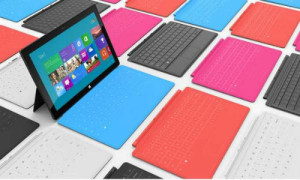 Eight months after the launch of Microsoft’s Surface line, the company has yet to turn a profit on its first foray into tablet manufacturing and sales, according to a Tuesday regulatory filing.
Eight months after the launch of Microsoft’s Surface line, the company has yet to turn a profit on its first foray into tablet manufacturing and sales, according to a Tuesday regulatory filing.
Microsoft’s annual report, filed yesterday with the U.S. Securities & Exchange Commission (SEC), noted that the Surface generated $853 million in revenue through June 30, the end of the company’s fiscal year. The Surface RT debuted in late October 2012, while the more expensive Surface Pro — the latter powered by Windows 8 rather than Windows RT — reached retail in early February 2013.
But the annual report also acknowledged that income was outweighed by expenses, including a $900 million write-off Microsoft announced earlier this month as well as an $898 million increase in advertising costs, an undisclosed portion of which was related to the tablets.
Two weeks ago, Microsoft first cut the price of the Surface RT by as much as 30% to spur sales, then days later took the $900 million charge against earnings to account for those discounts as well as component and accessory overstocks.
To put the $853 million in perspective, Surface revenue equaled about 5.5% of the Windows Division’s $16 billion in sales in the last three quarters, and just 3.3% of the $25.8 billion that Apple’s iPad generated in the same period.
Microsoft has not disclosed the number of Surface RT and Surface Pro tablets it has sold, and did not do so in Tuesday’s 10-K filing.
And using Microsoft’s revenue disclosure to come up with a sales figure is difficult for outsiders, said Sameer Singh, a smartphone and tablet analyst who writes at Tech-Thoughts. One way would be to estimate the Surface’s “average selling price,” or ASP, then divide that into the $853 million to arrive at a unit sales number.
“[That’s] a pretty tall order right now. Apart from the fact that we have two different base prices for the Surface RT and Surface Pro, we’d also need to estimate the product mix by storage capacity, sales with and without the keyboard accessory, and finally take into account the recent discounting,” said Singh in an email reply to questions Wednesday. “There are just way too many variables with very little data.”
Singh took a crack at an ASP by working backwards from Surface shipment estimates provided by researcher IDC. But he wasn’t satisfied with the resulting ASP range of $370 to $430, calling it “unusually low considering the fact that it includes the Surface Pro,” the upper-end tablet that starts at $899 and has not been discounted.
An ASP in Singh’s range would mean that Microsoft sold between 2 and 2.3 million Surface tablets in the eight months between October 2012 and June 2013.
However many Surface tablets Microsoft has sold, the important number is the revenue, said Singh: It’s so low that the company may face more bad news down the road.
“It looks like sales have been poor for the Surface Pro,” said Singh of the model powered by Windows 8. “Depending on build numbers, I wouldn’t be shocked if we see another inventory write-down for the Surface Pro over the next few quarters.”
Microsoft, however, has pledged to continue the Surface line, including the discounted Surface RT, even in the face of OEM defections. Earlier this week, Asus Chairman Jonney Shih said his company won’t launch new Windows RT-based tablets, putting Microsoft in a lonely spot as the only vendor backing the platform.
“We will continue to invest in new software and hardware products, services, and technologies, such as the Microsoft-designed and manufactured Surface,” Microsoft promised in the 10-K.
Elsewhere in the filing, Microsoft provided more details about the agreement it struck with former Windows chief Steven Sinofsky. Four weeks ago, Microsoft revealed that it had negotiated a multi-million dollar retirement deal with Sinofsky, who was ousted from the company late last year.
As part of the agreement, which will award Sinofsky cash equivalent to 418,000 shares of Microsoft stock, and to be paid in several installments through August 2016, the former executive was barred from working for “certain competitors” for the next 12 months. At the time, Microsoft did not identify those competitors.
It did in a document attached to Tuesday’s 10-K.
“Steven agrees that he will not for a period of twelve (12) months after the Separation Date … accept direct or indirect employment with the following companies: Amazon, Apple, EMC, Facebook, Google, Oracle [and] VMware,” the agreement stated.
Sinofsky also agreed not to make “any disparaging remarks about Microsoft, its officers or directors [or] its products” through Jan. 1, 2016.





